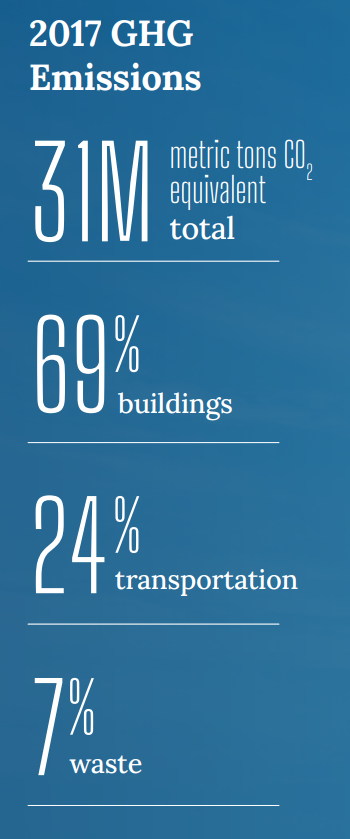Electrify Chicago
An independent tool for viewing City of Chicago building data
According to the
2022 Chicago Climate Action Plan,
69% of Chicago's emissions come from buildings, making
building emissions our biggest challenge and our biggest opportunity as a city
to tackle climate change. At Electrify Chicago, we showcase building performance using
publicly available data supplemented by community-submitted photographs and building
owners.
Start by looking at Chicago's buildings with the highest greenhouse gas intensity i.e. emissions per square foot. Large, efficient, buildings can perform much better than very inefficient small buildings on this metric.
New Article
📰 $30 Million In Missed Fines
The City Of Chicago failed to collect $30 million in potential fines from the building benchmarking ordinance, reducing transparency and accountability.
Legislative update! 🎉
As of late January 2024, legislation is being introduced to require new use more efficient forms of water and space heating, via the Clean And Affordable Buildings Ordinance (CABO), which will reduce the number of highly polluting and inefficient buildings that end up on this site.
If you're in Chicago,
write to your alderman to support the CABO!
Chicago Buildings by Greenhouse Gas Intensity
Note: Data includes large Chicago buildings with data from 2022, unless explicitly stated otherwise.
Note: This data only includes buildings whose emissions are reported
under the
Chicago Energy Benchmarking Ordinance. According to the City “As of 2016,
this list includes all commercial, institutional, and residential buildings larger than
50,000 square feet.” This dataset is also then filtered to only buildings with
reported emissions > 1,000 metric tons CO2 equivalent.
The latest year of data is from 2022, but we update the site regularly when new data is available, and some buildings may have failed to report that year, and only have older data available.
| Property Name / address | Primary Property Type |
Greenhouse Gas Intensity (kg CO2 eq./sqft) |
Total Greenhouse Emissions (metric tons CO2 eq.) |
|---|---|---|---|
|
The Parker Fulton Market
730 W COUCH PL
| Multifamily Housing | 6.4 kg/sqft
Lowest 49%
| 1,672 tons
Highest 28%
|
|
The Hudson
750 N HUDSON AVE
| Multifamily Housing | 6.4 kg/sqft
Lowest 49%
| 1,882 tons
Highest 25%
|
|
Sullivan Station Apartments
🕰️
(CHA)
1060 E 41st St
| Multifamily Housing | 6.4 kg/sqft | 632 tons |
|
North Park Village Apartments - Building E
5801 N Pulaski Rd - Bldg E
| Residential Care Facility | 6.4 kg/sqft
Lowest 49%
| 358 tons
Lowest 13%
|
|
4721 4729 S Ellis St
4721 4729 S Ellis St
| Multifamily Housing | 6.4 kg/sqft
Lowest 49%
| 401 tons
Lowest 17%
|
|
James Shields Ms -CPS
(CPS)
2611 W 48th St
| K-12 School | 6.4 kg/sqft
Lowest 49%
| 607 tons
Lowest 34%
|
|
Hedges Elementary -CPS
(CPS)
4735 S Winchester Ave
| K-12 School | 6.4 kg/sqft
Lowest 49%
| 650 tons
Lowest 37%
|
|
Edison Park Elementary -CPS
(CPS)
6220 N Olcott Ave
| K-12 School | 6.4 kg/sqft
Lowest 49%
| 386 tons
Lowest 16%
|
|
Cleveland Elementary, Grover -CPS
(CPS)
3121 W Byron St
| K-12 School | 6.4 kg/sqft
Lowest 49%
| 619 tons
Lowest 35%
|
|
Esmond Elementary -CPS
(CPS)
1865 W Montvale Ave
| K-12 School | 6.4 kg/sqft
Lowest 49%
| 346 tons
Lowest 12%
|
|
Dvorak Math/Science/Tech Academy - CPS
🕰️
(CPS)
3615 W 16th St
| K-12 School | 6.4 kg/sqft | 446 tons |
|
Home Depot, #1961 Elston/Leavitt
2542 Elston Ave
| Retail Store | 6.4 kg/sqft
Lowest 49%
| 760 tons
Lowest 44%
|
|
Lake Parc Place
(CHA)
3939 - 3983 S Lake Park Ave
| Multifamily Housing | 6.4 kg/sqft
Lowest 49%
| 1,873 tons
Highest 25%
|
|
Bowen Environmental Studies HS -CPS
🕰️
(CPS)
2710 E 89th St
| K-12 School | 6.4 kg/sqft | 1,896 tons |
|
111 E Chestnut Condominium Association
111 E Chestnut St
| Multifamily Housing | 6.4 kg/sqft
Lowest 49%
| 3,780 tons
Highest 10%
|
Data Source:
Chicago Energy Benchmarking Data
